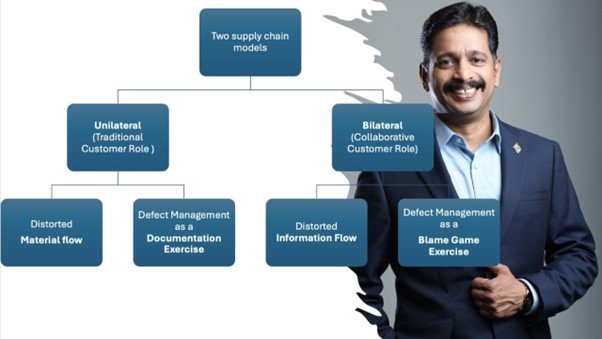In my extensive experience with supply chain transformation, I have encountered two fundamentally distinct supply chain paradigms that reflect varying degrees of customer involvement and systemic complexity.

The traditional model positions customers as passive end recipients. Their role is limited to placing orders with an implicit expectation that deliveries will meet stringent, predefined criteria—quantity, quality, price, and timeliness. This unilateral dynamic is characterized by minimal interaction between the customer and the supplier, with the emphasis placed on transactional efficiency rather than collaborative optimization.
In stark contrast, the collaborative model empowers customers to take an active, participatory role in the supply chain. Rather than simply receiving products, customers contribute key inputs—such as product designs, technical specifications, raw materials, expertise, and even samples, interim approvals, and external certifications. In this bilateral relationship, the customer’s involvement transcends mere procurement, evolving into a strategic partnership that requires intricate information exchange and synchronized decision-making.
In the unilateral model, material flow is frequently distorted due to entrenched management practices that prioritize local optimization—where individual functions or departments optimize for their own narrow goals without regard for the broader supply chain objectives. This results in bottlenecks, inventory imbalances, and delays that compromise the overall efficiency and responsiveness of the supply chain. The fragmentation of decision-making, coupled with limited visibility, exacerbates these issues, ultimately undermining delivery precision.
Conversely, in the bilateral model, flow distortions are often driven by misaligned or delayed information exchanges. This model requires a high degree of synchronization and real-time communication between the customer, supplier, and various intermediaries (e.g., logistics providers, third-party contractors). The quality and timeliness of this information flow directly influence the speed and accuracy of decision-making. When information is either inaccurate or untimely, it can significantly disrupt the flow of goods, leading to delayed deliveries and misaligned expectations.
Regardless of the supply chain model, addressing flow distortions demands a systemic, iterative approach rooted in defect management and continuous improvement. A comprehensive, data-driven methodology is essential to identify, analyze, and resolve the root causes of disruptions.
Despite the best efforts to optimize supply chains, two deeply ingrained mindsets within each model frequently hinder meaningful transformation:
In unilateral supply chains, defect management is often relegated to a mere compliance function. Issues are catalogued for audit purposes, without regard for their potential to drive systemic improvement. This mindset fosters a culture of complacency, where reactive problem-solving predominates, rather than focusing on root cause analysis and the implementation of sustainable solutions.
In bilateral supply chains, defect management often devolves into a blame-shifting exercise, where the primary objective becomes finger-pointing and penalizing stakeholders. The focus on penalties, such as liquidated damages, detracts from the opportunity to foster a collaborative problem-solving environment. This blame-centric approach fosters an adversarial dynamic, which can undermine long-term relationships and hinder the development of joint solutions.
The path to achieving sustainable, high-performance supply chains lies in transforming the customer role and adopting a more collaborative mindset. Whether working within a unilateral or bilateral system, organizations must prioritize systemic improvements that focus on optimizing both material and information flows.
Organizations that embrace this mindset and align incentives with a shared vision of success will be better positioned to navigate the complexities of supply chain transformation and achieve long-term success.
In particular, adopting a continuous improvement approach will empower organizations to: